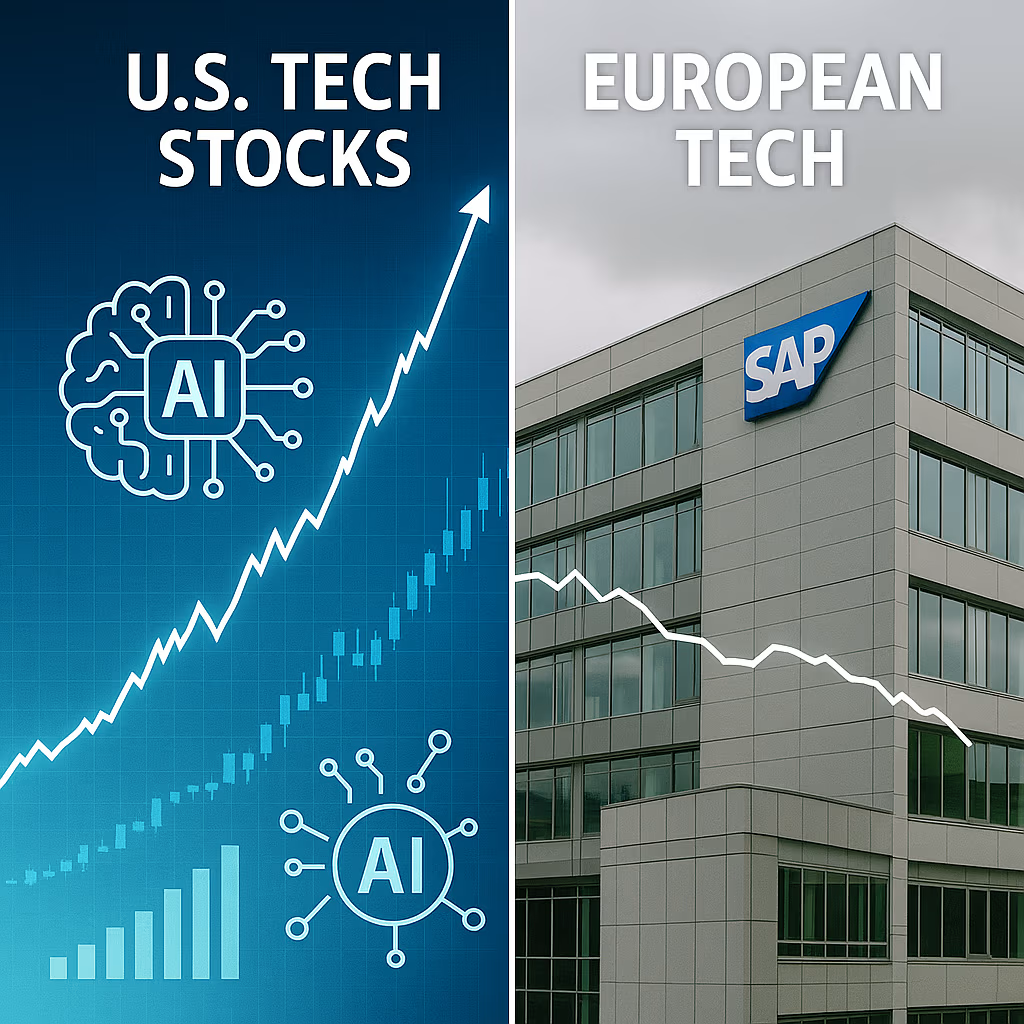While global markets have been swept up in the excitement of the artificial intelligence revolution, European technology stocks are telling a very different story. Despite AI driving valuations to record highs in the U.S., particularly among Silicon Valley heavyweights, Europe’s tech sector is struggling to capture the same investor enthusiasm. Disappointing earnings reports, muted growth forecasts, and structural challenges have combined to leave many European tech companies on the sidelines of the AI rally.
AI Momentum Stops at the Atlantic
In the United States, tech giants have seen their market capitalizations soar on the back of AI optimism, with cloud, semiconductor, and software leaders becoming the primary beneficiaries. In Europe, however, most publicly listed tech firms have yet to post the kind of transformative results that convince markets they are riding the same wave.
While some European companies are experimenting with AI applications—particularly in automation, cybersecurity, and fintech—their scale and market presence are far smaller than their U.S. counterparts. Without blockbuster AI product launches or large-scale integration into core revenue streams, investors remain cautious.
Earnings Season Brings More Bad News
Recent earnings announcements have underscored the challenge. Several prominent European tech companies have missed analyst expectations, citing weaker-than-anticipated demand, currency headwinds, and higher operating costs. Revenue growth has been modest, and in some cases, profits have contracted due to increased R&D spending without immediate payoff.
For investors who had hoped that AI integration would spark a rapid turnaround, these results have been disappointing. Instead of surging forward, many European tech stocks have traded sideways or declined, widening the performance gap with their U.S. peers.
Structural Disadvantages in the AI Race
Part of the problem lies in Europe’s structural position in the global technology market. While the region has strong research capabilities and a growing startup scene, it lacks the concentration of mega-cap tech firms with the resources to invest tens of billions annually in AI infrastructure. U.S. giants dominate the AI hardware supply chain, cloud platforms, and large language model development—areas where European players have limited market share.
Additionally, regulatory factors play a role. The European Union’s more cautious stance on data privacy, AI ethics, and digital market oversight can slow the rollout of commercial AI products compared to the more aggressive approach taken in the U.S. and parts of Asia. While these regulations aim to protect consumers, they can also reduce competitive speed in fast-moving markets.
Investors Shift Toward U.S. and Asia
The performance gap has not gone unnoticed by global investors. Capital flows have increasingly favored U.S. and Asian tech markets, where growth stories are more compelling and earnings momentum stronger. Exchange-traded funds tracking European tech indices have underperformed, and some portfolio managers are rotating out of European tech holdings altogether.
For European companies, this creates a feedback loop: weaker share prices make it harder to raise capital for large-scale AI investments, which in turn limits their ability to compete with well-funded rivals abroad.
Bright Spots in a Challenging Landscape
Not all European tech firms are missing out entirely. Select companies in niche markets—such as industrial automation, AI-powered cybersecurity, and specialized semiconductor design—are posting healthy growth and attracting targeted investor interest. These players often focus on sectors where Europe has a competitive edge, such as precision engineering, automotive technology, and advanced manufacturing.
However, these success stories are the exception rather than the rule, and they have yet to meaningfully shift overall market sentiment toward the region’s tech sector.
What Needs to Change
For European tech stocks to participate fully in the AI-driven market rally, several factors will need to align:
- Scaling Up AI Investments – Larger capital commitments to AI infrastructure, partnerships, and in-house product development.
- Improving Global Market Access – Expanding international operations to capture higher-growth AI demand outside Europe.
- Balancing Regulation and Agility – Streamlining regulatory approval processes without compromising consumer protections.
- Encouraging Public-Private Collaboration – Leveraging government funding and research institutions to accelerate commercial AI applications.
If European companies can address these challenges, they may yet close the performance gap with their global peers.
Opportunities Amid the Struggles
Despite current underperformance, Europe’s technology sector still holds long-term potential. The continent’s universities and research centers are producing top-tier AI talent, and the startup ecosystem continues to attract venture capital in areas such as green tech, fintech, and AI for industrial applications. If more of these companies can transition from promising startups to globally competitive public firms, investor sentiment could shift.
In the meantime, the disparity between European and U.S. tech stock performance serves as a reminder that AI’s benefits are not evenly distributed. For investors, the challenge lies in identifying which European firms can break free from the earnings drag and position themselves at the forefront of the next phase of AI-driven growth.





